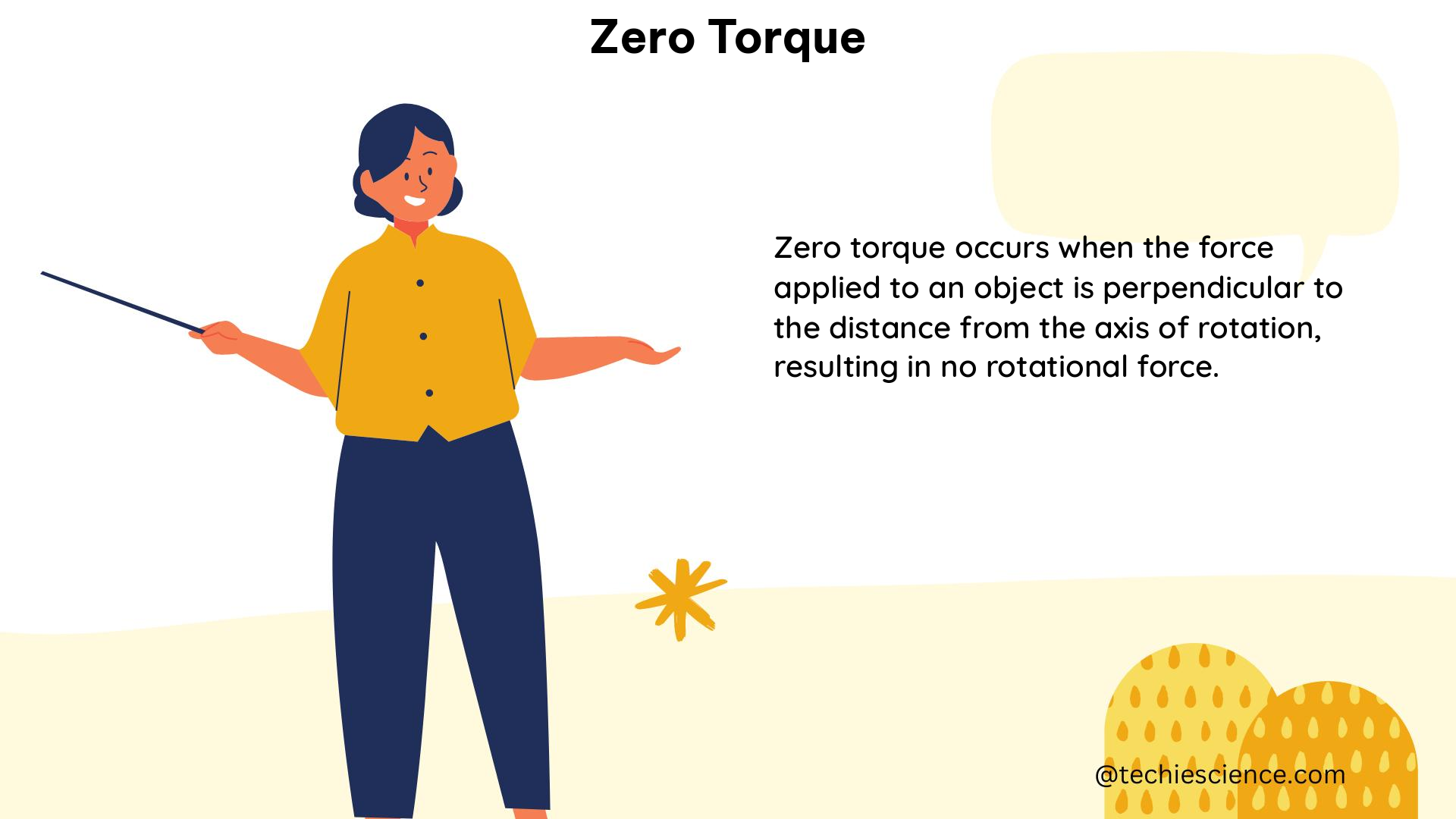Zero torque refers to a state where there is no rotational force being applied to an object. This can be observed in systems where the net force acting on the object is balanced, resulting in no rotational motion. Understanding the concept of zero torque is crucial for physics students as it underpins various fundamental principles, such as angular momentum, rotational equilibrium, and rotational kinematics.
The Torque Formula: Calculating Zero Torque
The formula for torque (τ) is a fundamental equation used to calculate the rotational force acting on an object:
τ = r F sin θ
Where:
– τ is the torque (in Newton-meters, Nm)
– r is the distance from the pivot point to the point of force application (in meters, m)
– F is the applied force (in Newtons, N)
– θ is the angle between the force and the line connecting the pivot point and the point of force application (in degrees or radians)
When any of these variables are zero, the torque will also be zero, resulting in a state of zero torque.
Example 1: Balanced Door
Consider a door that is perfectly balanced and has no force applied to it. In this case, the torque can be calculated as follows:
τ = r F sin θ
τ = (0.5 m) (10 N) sin 90°
τ = 0 Nm
In this example, the moment arm (r) is 0.5 meters, the force (F) is 10 Newtons, and the angle (θ) is 90 degrees. Since the force and angle are both zero, the torque is also zero, resulting in a state of zero torque.
Example 2: Straight-line Motion
Another example of zero torque is a stationary object being pushed or pulled in a straight line, resulting in no rotational motion. In this case, the angle between the force and the line connecting the pivot point and the point of force application is zero, making the sine of that angle also zero, resulting in zero torque.
Measuring Zero Torque

Zero torque can be measured using various types of torque sensors, such as:
- Rotary Torque Sensors: These sensors measure the rotational force applied to a shaft or other rotating component.
- Reaction Torsion Sensors: These sensors measure the torque applied to a stationary component, such as a housing or frame.
- Strain Gauge Torque Sensors: These sensors use strain gauges to measure the deformation of a component due to the applied torque.
One example of a high-precision torque sensor is the FUTEK TRH605 Rotary Torque Sensor, which can measure torque with a resolution of 0.01% FS and an accuracy of ±0.1% FS.
Zero Torque in Physics Concepts
The principle of zero torque is closely related to several key physics concepts:
Angular Momentum
In a system with zero torque, the angular momentum of an object will remain constant. For example, a wheel spinning at a constant angular velocity will continue to spin indefinitely if no external torque is applied.
Rotational Equilibrium
When the net torque acting on an object is zero, the object is in a state of rotational equilibrium. This means that the object is not experiencing any rotational acceleration and its angular velocity remains constant.
Rotational Kinematics
The equations of rotational kinematics, such as the relationship between angular displacement, angular velocity, and angular acceleration, are all based on the principle of zero torque.
Physics Examples and Numerical Problems
Example: Wheel Spinning at Constant Angular Velocity
Consider a wheel spinning at a constant angular velocity. If no external torque is applied, the wheel will continue to spin indefinitely due to its angular momentum. However, if an external torque is applied, the wheel’s angular velocity will change, either increasing or decreasing depending on the direction and magnitude of the torque.
Numerical Problem: Pulley System
In a pulley system, a force is applied to one end of a rope wrapped around the pulley. To calculate the torque acting on the pulley, you would need to know the force, the radius of the pulley, and the angle between the force and the line connecting the pivot point and the point of force application.
For example, if the force is 50 N, the radius of the pulley is 0.1 m, and the angle is 30 degrees, the torque can be calculated as follows:
τ = r F sin θ
τ = (0.1 m) (50 N) sin 30°
τ = 2.5 Nm
However, if the force is applied perfectly aligned with the line connecting the pivot point and the point of force application, the angle would be zero, making the sine of that angle also zero, resulting in zero torque.
Conclusion
Zero torque is a fundamental concept in physics that underpins various principles and equations. By understanding the formula for torque, the methods for measuring zero torque, and the applications of zero torque in different physics concepts, students can develop a deeper understanding of rotational motion and its underlying principles. This comprehensive guide provides a hands-on playbook for physics students to master the concept of zero torque and apply it to a wide range of problems and scenarios.
References:
– FUTEK Torque Measurement
– How to Measure Torque
– Why if the Torque Equals Zero Measured from One Point in Space, it Equals Zero in Any Other Point?
– Torque Tutorial
I am Keerthi K Murthy, I have completed post graduation in Physics, with the specialization in the field of solid state physics. I have always consider physics as a fundamental subject which is connected to our daily life. Being a science student I enjoy exploring new things in physics. As a writer my goal is to reach the readers with the simplified manner through my articles.